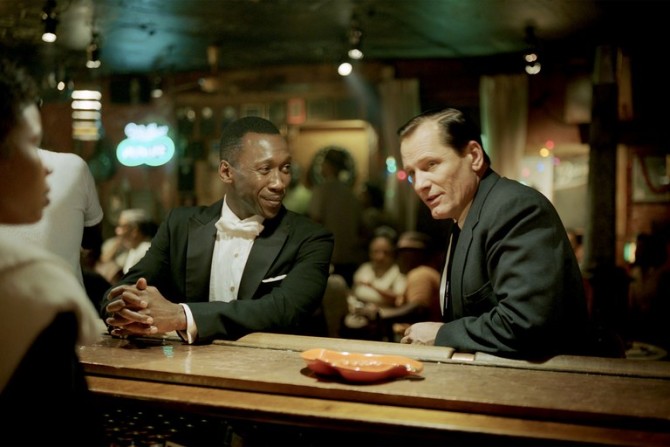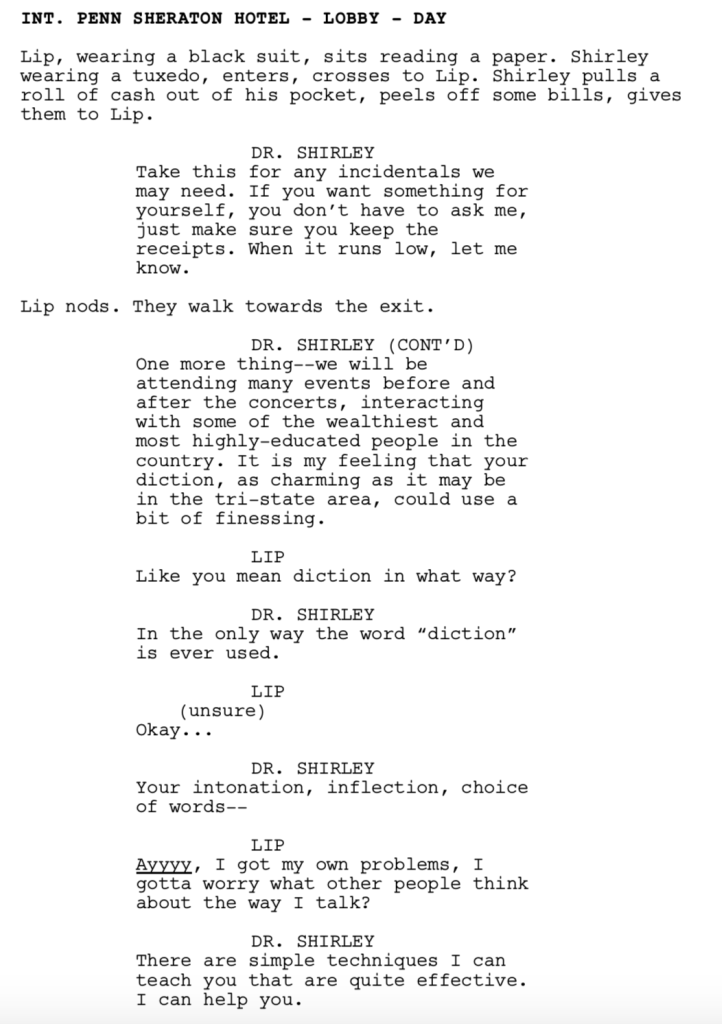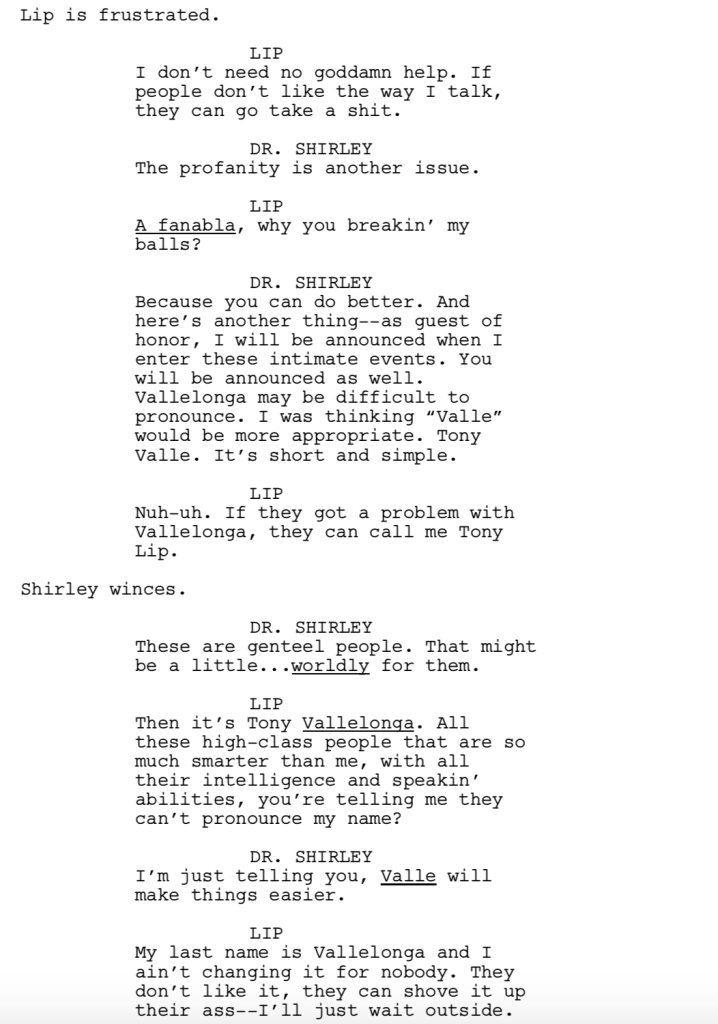We’re in the midst of a dialogue crisis.
Outside of Get Home Safe, a lot of the dialogue I’ve been reading lately has been downright forgettable. It didn’t take long to figure out why that is. A lot of the current dialogue out there lacks LIFE. And I have a theory as to why. There are very few people who can actually write good dialogue. There are even fewer people who know how to teach good dialogue. So what everybody does is create a new world order whereby the best dialogue is as little dialogue as possible.
Do these mainstays sound familiar? “Less is more.” “Come in as late as possible. Leave as early as possible.” “Show don’t tell.” If you told any screenwriting guru that they could only use one anecdote when talking to an audience of screenwriters, the one they would all choose is the scene where a married couple is in an elevator, the doors open, a beautiful woman walks in, the man takes off his hat and gives her a giant smile, and the wife, seeing this, takes a step away from her husband (there are several variations of this scene but this is the most popular). The reason gurus love this scene so much is because it says everything without the characters saying anything.
But here’s the problem with that. YOU CAN’T DO IT EVERY SCENE!!!! If you did, you’d have the most boring script ever. Here’s a newsflash: YOUR CHARACTERS HAVE TO TALK SOMETIMES. IF you keep running from that, not only will your script be unrealistic, but we’ll never get to know the characters. Sure, a character action tells us a ton about a person. But you know what also tells us a lot about a person? WHEN THEY TALK!
The anti-dialogue movement can be traced back to two periods. Period One was the Tarantino knock-offs. When Pulp Fiction became huge, everybody wrote their big dialogue-driven movie. What the industry and audiences quickly found out, however, is that not everyone can write cool off-the-cuff effortless dialogue like Tarantino. So in order to rein everyone back in, teachers, gurus and producers encouraged the less is more approach. Let’s get back to basics and only have people say things when they actually have to say things.
Period 2 was Juno. Juno was even more influential in curbing dialogue than the Tarantino Knock-Off Era because the movie’s backlash came at the beginning of everyone rushing to the internet to complain about everything they didn’t like about a movie. So that fun punchy overly stylized dialogue that Diablo Cody wrote was now considered persona non grata. You’d be better off writing a silent film than one with Diablo Cody dialogue.
Now I’m not knocking these age-old screenwriting lessons. Less is more in a lot of cases. For the most part, you should come in late and leave early. And showing me something is often going to be more impactful than telling me about it. But that doesn’t mean you should fear dialogue. You still want scenes where you let go and allow your characters to speak. Because what I’m encountering with this warped less-is-always-more view is that I leave the story feeling like I never got to know the characters. And if they would’ve had a few more conversations, that would’ve been different. I mean this isn’t rocket science here. How do you get to know someone? BY HAVING A CONVERSATION WITH THEM.
Now the tricky thing about screenwriting is that you have to do this, but you still have to dramatize it. In other words, you can’t put two characters across from each other in a diner booth and have them talk for 20 minutes and then when the Black List reader complains that he was bored, say, “Well Scriptshadow said it was okay because we needed to get to know the characters better.” No. Having long boring conversations at the expense of entertainment is not what I’m advocating. You have to figure out a way to maneuver these conversations into some sort of dramatic framework.
A big reason why the diner scene between Vincent and Mia in Pulp Fiction works even though it’s a big long dialogue scene with characters sharing their thoughts, is that Mia is one of the sexiest women on the planet, she’s flirting with Vincent, and she also happens to be the wife of his gangster boss. If he indulges in anything with this woman, his life is literally at stake. There’s tons of conflict in this scene even though it’s just two people talking. So that’s the catch. You want to add more dialogue to your scripts, but you have to do so within a framework where we’re still being entertained in the process.
So let’s say you master that part. You at least know how to a set up a scenario whereby your characters can talk and it not be boring. How do you then write memorable dialogue? What’s the trick to making those words sing in a way that gets everyone lauding you as the next great dialogue writer? Well, that’s the secret sauce isn’t it? If it were only so easy. The problem with writing great dialogue is that much of the advice that gets you there is not directly actionable. For example, if I say, “Keep your script under 110 pages,” that’s actionable. You have a clear directive to follow. But if I say, “Your dialogue is too bland. It needs more flavor,” it isn’t clear what one can do to add more “flavor.” This list below is the best I can do to bridge that gap for you. But ultimately, dialogue is a living breathing organism that can never be quantified. Its beauty, or lack thereof, will always be elusive.
1) Get into conversations with different types of people and pay attention to how they talk and what they say.
2) Dialogue, more than any other type of writing is about not thinking when you write. Let go and allow the characters to speak. See what comes out. You can always edit it back later if you go too far.
3) Understand your characters’ socio-economic backgrounds. This differentiates the characters and adds color to the dialogue. Someone from the Bronx will speak differently than someone from Silicon Valley.
4) Research vocabulary and slang on Youtube for character types unfamiliar to you. Bo Burnham did this with his characters in Eighth Grade.
5) Knowledge. The more you know about a subject matter, the more detail you can include in the dialogue. Aaron Sorkin is a master at this.
6) Embrace messiness. Real conversation is never perfect. Some people are distracted. Others mishear things. Some don’t care. Characters should never feel like they’re chess pieces waiting to be spoken through. They should speak of their own accord.
7) When conceiving of your story, include a couple of characters who like to talk, since those are the characters who often say the most interesting things. There’s nobody who liked to speak more than Steve Job in Sorkin’s, “Jobs.”
8) Every single person has their own unique sense of humor. Since humor is one of the most defining qualities, figure out what type of humor your character gravitates to. Gallows? Sarcasm? Dad-jokes? Dirty? Makes jokes at the expense of others?
9) Dress dialogue up. Phrase things in ways that nobody else would’ve thought of.
10) Listen to a lot of people, talk to a lot more, and study dialogue in all the great dialogue-driven movies – pausing every time you liked an exchange and asking yourself why.
I want to finish this off by posting a scene from the movie Green Book. I’ve never seen Green Book. However, one look at the characters and I knew they were designed for dialogue (one is highly educated while the other grew up on the streets). I flipped to a random scene in the middle of the script and I got this. The scene doesn’t hit all the beats I’ve discussed today (It’s relatively short). But it does get the characters talking to each other. It highlights the differences between their socio-economic backgrounds. One speaks eloquently. The other does not. And the scene has a dramatic purpose. They’re not just chatting. They’re working through a problem (Dr. Shirley needs Lip to look and act more refined for an upcoming event). Most importantly, I have a better sense of who these two people are after this conversation. For those who haven’t seen the film, Dr. Shirley (Mahershala Ali) is a famous black gay musician and Lip (Viggo Mortenson), a brute tough guy, is driving him cross-country from concert to concert.
I would love to hear your tips on writing better dialogue. And no, I don’t mean “include conflict,” and “less is more,” and “the best dialogue is when there’s no dialogue.” I mean when your characters ACTUALLY CONVERSE WITH EACH OTHER, how do you make it sound better? Discuss!





